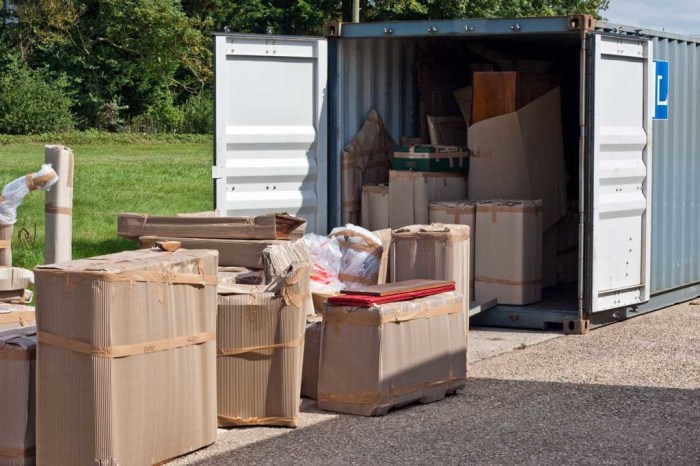Shipping furniture presents unique challenges due to its size, weight, and fragility. This comprehensive guide explores the complexities of furniture shipping, offering insights into the available methods, packaging techniques, cost factors, and customer experience. From understanding industry trends to implementing sustainable practices, we delve into the intricacies of shipping furniture, empowering you to make informed decisions and ensure your furniture arrives safely and efficiently.
Furniture Shipping Market Overview
The global furniture shipping market has witnessed a remarkable growth trajectory in recent years, driven by the burgeoning e-commerce industry and the increasing demand for home furnishings. In 2023, the market was valued at approximately $350 billion, and it is projected to expand at a steady compound annual growth rate (CAGR) of 5.5% over the next five years, reaching $490 billion by 2028.
Key Market Trends
- Rising Popularity of Online Furniture Shopping:The advent of e-commerce platforms has revolutionized the furniture industry, making it easier and more convenient for consumers to purchase furniture from the comfort of their homes. This has led to a surge in demand for furniture shipping services.
- Growth of the Home Improvement Market:The rising trend of home renovations and remodeling has fueled the demand for furniture, as homeowners seek to update and enhance their living spaces. This has contributed to the growth of the furniture shipping market.
- Emergence of Sustainable Shipping Practices:Consumers are becoming increasingly environmentally conscious, which has led to a demand for sustainable shipping practices in the furniture industry. Furniture shippers are responding by adopting eco-friendly packaging materials and reducing carbon emissions.
Emerging Technologies
- Automated Loading and Unloading Systems:Advanced automated systems are being deployed to streamline the loading and unloading processes, reducing labor costs and improving efficiency.
- Real-Time Tracking and Monitoring:Advanced tracking and monitoring technologies enable furniture shippers to track the location of their shipments in real-time, providing greater visibility and peace of mind.
- Artificial Intelligence (AI):AI-powered solutions are being used to optimize shipping routes, predict demand, and provide personalized recommendations to customers.
Challenges in Furniture Shipping

Furniture shipping presents unique obstacles due to the inherent characteristics of furniture items, such as their size, weight, and fragility. These factors contribute to challenges that impact the efficiency, cost, and safety of the shipping process.
Shipping furniture can be a time-consuming process, but it doesn’t have to be. If you’re looking for a way to get your furniture delivered quickly and efficiently, consider using a same day furniture removal service like same day furniture removal . These services can help you move your furniture quickly and easily, so you can get back to enjoying your new home or office.
Shipping furniture doesn’t have to be a hassle – with the right service, it can be a breeze.
Common issues encountered in furniture shipping include:
Damage
The bulky nature of furniture makes it susceptible to damage during handling, transportation, and storage. Improper packaging, inadequate cushioning, and rough handling can lead to scratches, dents, breakage, and other forms of damage.
Delays
Furniture shipping often involves complex logistics and coordination. Delays can occur due to factors such as availability of specialized equipment, weather conditions, and customs clearance issues. These delays can result in missed delivery deadlines and inconvenience for customers.
Cost Overruns
The size and weight of furniture significantly impact shipping costs. Additionally, the need for specialized packaging, handling equipment, and insurance can further increase expenses. Unexpected delays or damage can also lead to additional costs.
Shipping Methods for Furniture: Shipping Furniture
The selection of an appropriate shipping method is crucial for ensuring the safe and efficient delivery of furniture. There are several options available, each with its own advantages and disadvantages.
Truckload Shipping
Truckload shipping is suitable for large quantities of furniture, typically requiring a full truckload. This method offers cost-effectiveness for bulk shipments and provides dedicated transportation, ensuring timely delivery.
Less-than-Truckload (LTL) Shipping, Shipping furniture
LTL shipping is ideal for smaller quantities of furniture that do not require a full truckload. This method involves consolidating shipments from multiple customers onto a single truck, resulting in lower costs compared to truckload shipping. However, it may lead to longer transit times due to multiple stops.
White-Glove Delivery
White-glove delivery is a premium shipping service that provides specialized handling and care for high-value or delicate furniture. This method includes unpacking, assembly, and placement of furniture within the customer’s home, ensuring utmost safety and convenience.
When it comes to shipping furniture, it’s important to find a reliable and experienced provider. For those in the Naples, Florida area, Havertys Furniture Naples FL offers a wide selection of high-quality furniture and exceptional shipping services. Their team of experts will ensure that your furniture arrives safely and securely to your doorstep, making the entire process hassle-free.
Packaging and Protection for Furniture Shipping
Proper packaging and protection are crucial for ensuring that furniture arrives at its destination undamaged. Furniture pieces can be delicate and susceptible to damage during transit, making it essential to take appropriate measures to safeguard them.
To ensure the safety of your furniture during shipping, there are several best practices to follow when packing and securing it:
Packing Materials
- Use sturdy cardboard boxes that are the appropriate size for the furniture piece.
- Wrap furniture in bubble wrap, packing paper, or foam to protect it from scratches and dents.
- Fill empty spaces within the box with packing peanuts or crumpled newspaper to prevent movement and shifting during transit.
Securing Furniture
- Dismantle furniture pieces whenever possible to reduce their size and make them easier to pack.
- Use packing tape to secure furniture pieces together and prevent them from coming apart during transit.
- Place heavy items on the bottom of boxes and lighter items on top to prevent crushing.
Special Considerations
- For fragile items, such as glass or marble, use extra layers of protection, such as bubble wrap and foam.
- For upholstered furniture, cover it with a plastic wrap to protect it from dirt and moisture.
- Label boxes clearly with the contents and indicate which side should be up to prevent mishandling.
By following these best practices, you can significantly reduce the risk of damage to your furniture during shipping and ensure that it arrives at its destination in pristine condition.
Cost Factors in Furniture Shipping
The cost of furniture shipping is influenced by several key factors. Understanding these factors can help you optimize your shipping expenses.
Distance
The distance between the origin and destination significantly impacts shipping costs. Longer distances typically incur higher transportation charges.
Weight
The weight of the furniture is another crucial factor. Heavier items require more resources to transport, resulting in increased shipping costs.
Handling Fees
Handling fees cover the labor involved in loading, unloading, and handling the furniture during the shipping process. These fees can vary depending on the size, weight, and fragility of the items.
Tips for Optimizing Shipping Costs
- Choose a reputable shipping company with competitive rates.
- Consider shipping during off-peak seasons or weekdays.
- Negotiate discounts for bulk shipments.
- Package your furniture carefully to minimize damage and reduce handling fees.
- Compare quotes from multiple shipping companies to secure the best deal.
Customer Experience in Furniture Shipping
Providing a positive customer experience is crucial in furniture shipping, as it can significantly impact brand reputation, customer loyalty, and repeat business.
Common customer pain points include:
- Delayed deliveries
- Damaged or defective furniture
- Poor communication and customer service
- Hidden costs and fees
Addressing Customer Pain Points
To address these pain points, furniture shipping companies should:
- Provide accurate and timely delivery estimates
- Use proper packaging and protection to prevent damage
- Establish clear communication channels and respond promptly to inquiries
- Be transparent about all costs and fees associated with shipping
Sustainable Practices in Furniture Shipping
Furniture shipping can significantly impact the environment due to the large volumes of packaging materials used and the emissions produced during transportation. Implementing sustainable practices is crucial to reduce the environmental footprint of furniture shipping.
When shipping furniture, it’s important to ensure that the pieces arrive in pristine condition. One question that often arises is, “is coleman furniture legit?” To address this, click here . Returning to the topic of shipping furniture, proper packaging and secure transportation are crucial for ensuring the longevity of your prized possessions.
Eco-friendly Packaging
One key area for sustainable practices is eco-friendly packaging. Furniture can be packaged using biodegradable or recyclable materials such as cardboard, paper, and jute. These materials minimize waste and reduce the need for landfill space. Additionally, reusable packaging systems can be employed to eliminate single-use packaging.
Case Studies in Furniture Shipping

Case studies offer valuable insights into successful furniture shipping operations. They showcase best practices, lessons learned, and strategies that have led to efficient and satisfactory shipping experiences.
Successful Furniture Shipping Operations
One notable case study is that of IKEA, the Swedish furniture giant. IKEA has established a robust shipping system that ensures the timely and safe delivery of its products worldwide. The company utilizes various shipping methods, including container ships, rail, and road transport, to cater to different customer needs and geographic locations.
Another example is Wayfair, an American online furniture retailer. Wayfair has partnered with multiple shipping carriers to provide a range of delivery options, including standard, express, and white-glove delivery. The company’s focus on customer satisfaction and its commitment to transparent shipping policies have contributed to its success in the furniture shipping industry.
Final Conclusion

Shipping furniture involves a delicate balance of protection, cost-effectiveness, and customer satisfaction. By carefully considering the challenges, selecting the appropriate shipping method, employing proper packaging techniques, and optimizing costs, you can ensure a seamless and successful furniture shipping experience. Embracing sustainable practices further demonstrates your commitment to environmental responsibility and aligns with growing customer expectations.
Question Bank
What are the common challenges in shipping furniture?
Furniture shipping poses challenges due to its size, weight, and fragility, leading to potential issues such as damage, delays, and cost overruns.
How can I choose the right shipping method for my furniture?
The choice of shipping method depends on factors like the size, weight, and value of your furniture. Truckload shipping is suitable for large quantities, LTL for smaller shipments, and white-glove delivery for valuable or fragile items.
What are the key cost factors in furniture shipping?
Distance, weight, and handling fees are the primary cost factors in furniture shipping. Optimizing shipping costs involves considering factors like shipment consolidation and negotiating with carriers.